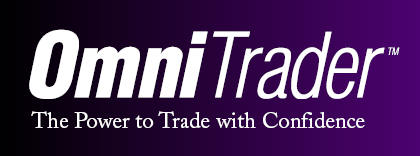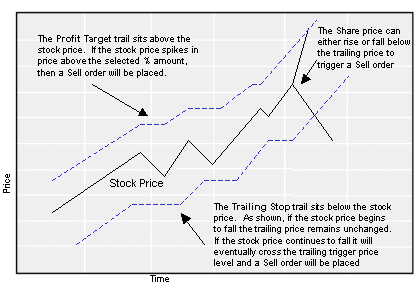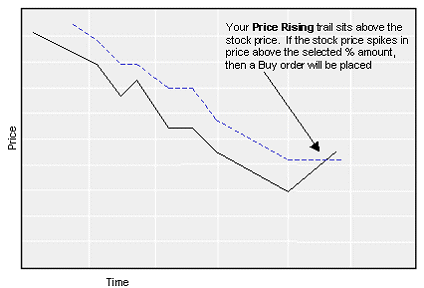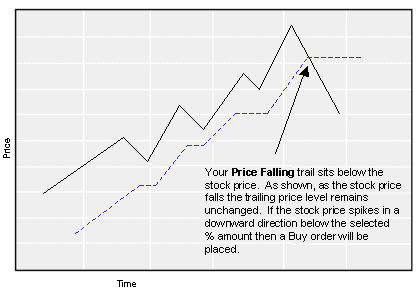

A Trailing Sell is a Conditional Order that uses a trailing price mechanism to instruct when to place a SELL order on existing stock holdings.
You choose the Trigger Price as a Trailing Percentage based upon yesterday’s High/Low/Close. This Sell Trigger Price is then recalculated overnight and is not a static figure. If the stock price falls or rises to the Trigger Price, you should activate a trade. There are two types of Trailing Sell orders; Profit Target and Trailing Stop orders.
If the share price rises the trailing Sell price will follow the share price up.
As the share rises in price the trailing stop price adjusts the price that the stock will have to reach to trigger a Sell order. It is recalculated daily and will follow the share price in an upward direction only. If the share price begins to fall the trailing percentage locks in place and stays at the same price as the previous day - it does not move down. If the share price continues to fall it will eventually hit the Trigger Price and will trigger the Conditional Order. The trailing price mechanism only ever moves upwards or horizontal, it never moves down.
| Trailing Sell Conditional Order |
 |
The use of a percentage tracking method means your Trigger Price can readjust in line with share price fluctuations. For example, you purchase 1000 shares at $9 each. At the same time you set a Basic Conditional Order to sell the shares if the price falls to $8.50. The share price rises to $14, then over time falls down to $8.50, at which time your Sell order is placed and executes. As a result, you have missed out on the opportunity to Sell the stock when the price rose to its high of $14. A Trailing Sell order allows you to track such price movements – in this example you could have sold the stock just after it began to fall from the $14 mark.
A Trailing Buy is a Conditional Order that uses a trailing price mechanism to instruct when to place a BUY order on a selected stock. You choose the Trigger Price set as a trailing percentage based upon yesterday’s high/low/close. This Buy Trigger Price is then recalculated overnight and is not a static figure, unlike the basic Price and Volume order. If a stock falls to or rises to the Trigger Price a Buy order will be placed to market for you. There are two types of Trailing Buy orders - Price Rising and Price Falling.
For a Price Rising – the trailing price mechanism only ever moves downwards or horizontal, it never moves up. The trailing buy will only ever trigger a Buy order if the stock price changes direction and moves in price upwards to reach your Trigger Price.
| Trailing Buy Conditional Order - Price Rising |
 |
For a Price Falling – the trailing price mechanism only ever moves upwards or horizontal, it never moves down. The trailing buy will only ever trigger a Buy order if the stock price changes direction and moves in price downwards to reach your Trigger Price.
| Trailing Buy Conditional Order - Price Falling |
 |
An example of using a Trailing Buy order is you are interested in purchasing NCP stock when the share price increases by 5% above yesterday’s high. This is a Price Rising Buy. As the share price falls the trailing Buy will follow the share price down. When the share price begins to rise, the trailing buy Trigger Price will remain where it is. If the share was to reach or rise above this level then your Conditional Order would trigger, your Order Vetted and a Buy order placed in the market.